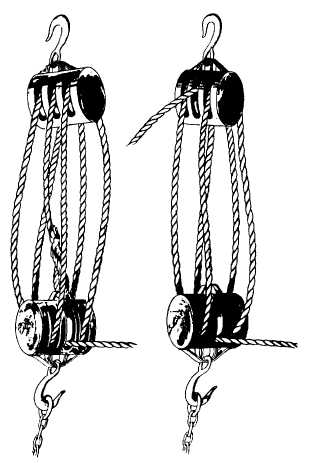Figure 2-8.-Some other tackles.
Many combinations of single-, double-, and triple-
sheave blocks are possible. Two of these combinations
are shown in figure 2-8.
You can secure the dead end of the fall to the
movable block. The advantage is increased by 1. Notice
that this is done in figure 2-7. That is a good point to
remember. Remember, also, that the strength of your
fall—rope—is a limiting factor in any tackle. Be sure
your fall will carry the load. There is no point in rigging
a 6-fold purchase that carries a 5-ton load with two triple
blocks on a 3-inch manila rope attached to a winch. The
winch could take it, but the rope couldn’t.
Now for a review of the points you have learned
about blocks, and then to some practical applications
aboard ship:
With a single fixed block the only advantage is the
change of direction of the pull. The mechanical
advantage is still 1.
A single movable block gives a mechanical
advantage of 2.
Figure 2-9.-A yard and stay tackle.
Many combinations of single, double, and triple
blocks can be rigged to give greater advantages.
Remember that the number of parts of the fall going
to and from the movable block tells you the approximate
mechanical advantage of the tackle.
If you fix the dead end of the fall to the movable
block you increase the mechanical advantage by one 1.
APPLICATIONS AFLOAT AND ASHORE
We use blocks and tackle for lifting and moving jobs
afloat and ashore. The five or six basic combinations are
used over and over in many situations. Cargo is loaded
aboard, and depth charges are stored in their racks. You
lower lifeboats over the side with this machine. We can
swing heavy machinery, guns, and gun mounts into
position with blocks and tackle. In a thousand situations,
sailors find this machine useful and efficient.
We use yard and stay tackles aboard ship to pick up
a load from the hold and swing it onto the deck. We use
yard and stay tackles to shift any load a short distance.
Figure 2-9 shows you how to pick a load by the yard
tackle. The stay tackle is left slack. After raising the load
to the height necessary to clear obstructions, you take
up on the stay tackle and ease off on the yard fall. A
glance at the rig tells you that the mechanical advantage
of each of these tackles is only 2. You may think it’s hard
work to rig a yard and stay tackle when the small
advantage is to move a 400-pound crate along the deck.
However, a few minutes spent in rigging may save many
unpleasant hours with a sprained back.
If you want a high mechanical advantage, a luff
upon luff is a good rig for you. You can raise heavy loads
with this setup. Figure 2-10 shows you what a luff upon
2-4



